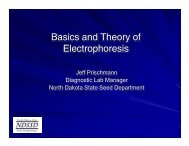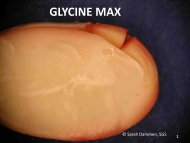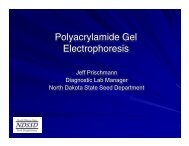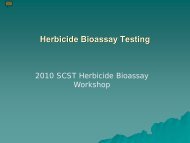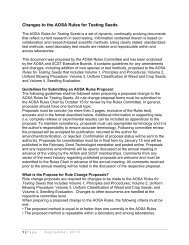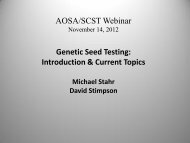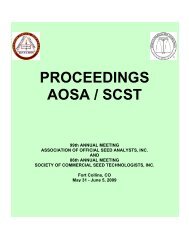Starch Gel Electrophoresis Techniques
Starch Gel Electrophoresis Techniques
Starch Gel Electrophoresis Techniques
Create successful ePaper yourself
Turn your PDF publications into a flip-book with our unique Google optimized e-Paper software.
<strong>Starch</strong> <strong>Gel</strong> <strong>Electrophoresis</strong><br />
<strong>Techniques</strong><br />
Carol Betzel, RGT<br />
<strong>Electrophoresis</strong> Lab Supervisor<br />
BioDiagnostics, Inc.<br />
River Falls, WI
Reference Manual<br />
<strong>Techniques</strong> and Scoring Procedures for<br />
<strong>Starch</strong> <strong>Gel</strong> <strong>Electrophoresis</strong> of Enzymes<br />
from Maize (Zea mays L.)<br />
C. W. Stuber<br />
J. F. Wendel<br />
M. M. Goodman<br />
J. S. C. Smith<br />
Technical Bulletin 286<br />
March 1988<br />
North Carolina Agricultural Research Service<br />
North Carolina State University<br />
Raleigh, North Carolina
What is <strong>Starch</strong> <strong>Gel</strong> Isozyme<br />
<strong>Electrophoresis</strong>?<br />
Isozyme=Protein<br />
Proteins are charged molecules<br />
Isozyme <strong>Electrophoresis</strong> is a technique of<br />
separating multiple forms of an enzyme<br />
(isozymes) from each other<br />
A starch gel is the matrix in which the<br />
molecules are separated when an electrical<br />
field is applied
What are Isozymes?<br />
<br />
Isozymes are multiple molecular forms of<br />
specific enzymes<br />
<br />
A single gene determines each molecular<br />
form of an isozyme<br />
<br />
The occurrence of different forms of an<br />
isozyme is governed by simple Mendelian<br />
Genetics
Reference Manual Contents<br />
<br />
<br />
<br />
<br />
<br />
Equipment<br />
<br />
Sample prep, gel trays, slicing apparatus<br />
Procedures<br />
<br />
<br />
<br />
Sample and gel prep<br />
<strong>Gel</strong> and staining solution recipes<br />
Enzyme systems<br />
Scoring Procedures; common nomenclature<br />
References<br />
List of supplies
<strong>Gel</strong> Mold
Maize Chromosome Map<br />
Each gene had been mapped to a locus.
<strong>Gel</strong> Making<br />
Determine gel system needed<br />
Single or multiple gels: # of loci needed<br />
Need consistent starch product<br />
Need consistent taring and gel making<br />
procedures
“B” <strong>Gel</strong> Ingredients<br />
L-histidine pH 5.7
Trouble Shooting for <strong>Gel</strong><br />
Quality<br />
Water quality<br />
pH<br />
<strong>Starch</strong> source (hydrolyzed starch)<br />
<strong>Starch</strong> and sucrose amounts<br />
Proper gel preparation procedures
<strong>Gel</strong> Mold
<strong>Gel</strong> Mold with Open “Legs”
<strong>Gel</strong> Mold—Taping
<strong>Gel</strong> Mold—Taped
Pouring the <strong>Gel</strong>
Sample Preparation<br />
Coleoptile<br />
Leaf<br />
Brace root<br />
Pollen<br />
(Seed used in IEF)
Harvesting Coleoptile Tissue<br />
REPRESENTATIVE SAMPLE IS CRITICAL!<br />
DON’T SKIP THE SMALL COLEOPTILES!
Sample Preparation<br />
Use control with a known banding<br />
pattern<br />
Use female and male controls for<br />
hybrids—not needed if previously tested<br />
and banding patterns are recorded in a<br />
database
Extraction Buffer<br />
Releases proteins from tissue<br />
Homogenizes the tissue sample
Add to<br />
each<br />
well<br />
Extraction Buffer
Use to<br />
crush<br />
seedlings<br />
Crusher
Releases<br />
proteins<br />
from<br />
tissue<br />
Crushing Coleoptiles
Paper Wick
Loading <strong>Gel</strong>s<br />
Sample absorbed onto paper wick is<br />
inserted into gel<br />
Important to keep lanes in correct order<br />
when loading<br />
Documentation of loaded samples is<br />
critical
Samples From One Seed Lot
Remove<br />
tape<br />
from gel<br />
mold leg<br />
Removing Tape from <strong>Gel</strong> Mold
Cut off<br />
meniscus<br />
Leveling <strong>Gel</strong> Top
Cut slit<br />
to insert<br />
wick<br />
Loading <strong>Gel</strong>
Inset<br />
wick—<br />
section 1<br />
Loading <strong>Gel</strong>
Inset<br />
wick—<br />
section<br />
2<br />
Loading <strong>Gel</strong>
<strong>Gel</strong> loading<br />
completed;<br />
insert<br />
marker dye<br />
to measure<br />
migration<br />
distance<br />
Loaded <strong>Gel</strong>
Running the <strong>Gel</strong><br />
Electrical power source<br />
Electrodes, + and – charge<br />
Choose constant:<br />
<br />
<br />
<br />
Milliamps (Current)<br />
Watts (Power) or<br />
Volts (Voltage)
Ohm’s Law<br />
<br />
<br />
I=E/R<br />
<br />
Electric current is directly proportional to voltage<br />
and inversely proportional to resistance<br />
Electrical Parameters<br />
<br />
<br />
<br />
<br />
I = Currant (amps)<br />
E = Voltage (volts)<br />
R = Resistance (ohms)<br />
P = Power (watts)
Fill<br />
buffer<br />
trays<br />
Running the <strong>Gel</strong>
Place<br />
gel mold<br />
in buffer<br />
trays<br />
Running the <strong>Gel</strong>
Running the <strong>Gel</strong><br />
Connect<br />
to<br />
electrical<br />
leads;<br />
Positive<br />
+ and<br />
Negative<br />
- charge
Set upper<br />
limit for<br />
desired<br />
constant<br />
and run gel<br />
for several<br />
hours to<br />
separate<br />
bands<br />
Running the <strong>Gel</strong>
Before <strong>Electrophoresis</strong><br />
Proteins are polarized molecules<br />
Origin
After <strong>Electrophoresis</strong><br />
origin<br />
<strong>Gel</strong> acts as a sieve; molecules move through and<br />
separate in electric field
Running the <strong>Gel</strong><br />
<br />
Speed of migration determined by<br />
<br />
<br />
<br />
<br />
<br />
<br />
<br />
<br />
Temperature<br />
Density of gel<br />
Setting of mAmps, Watts, or Volts<br />
Type of buffer<br />
pH of gel<br />
Concentration of buffer<br />
Molecular size and shape of proteins<br />
Net charges
Running the <strong>Gel</strong><br />
Need to keep the gel cold or:<br />
<br />
<br />
<br />
<br />
Proteins will degrade<br />
Bands will appear distorted<br />
Bands will diffuse<br />
Loss of enzymatic activity
Slicing the <strong>Gel</strong><br />
<br />
<br />
Slice gel into several separate slices<br />
Each slice is stained with a different protein<br />
specific stain. Examples:<br />
ACP Acid phosphatase<br />
ADH Alcohol dehydrogenase<br />
GLU β-glucosidase<br />
IDH Isocitrate dehydrogenase<br />
MDH Malate dehydrogenase<br />
PGD 6-phosogluconate dehydrogenase<br />
PGM Phosphoglucomutase
Slicing the <strong>Gel</strong><br />
<br />
Additional stains.<br />
ACO Aconitase<br />
AMP Arginine aminopeptidase<br />
CAT Catalase<br />
DIA Diaphorase<br />
ENP Endopeptidase<br />
EST Esterase<br />
GOT Glutamate-oxaloacetate transaminase<br />
PHI Phosphohexose isomerase<br />
SAD Shikimic acid dehydrogenase
Cut notch in<br />
corner for<br />
orientation<br />
Removing <strong>Gel</strong> from Mold
Removing gel from mold
Removing <strong>Gel</strong> from Mold
Draw<br />
wire<br />
through<br />
gel<br />
Slicing the <strong>Gel</strong>
Remove<br />
plastic<br />
strip on<br />
each<br />
side of<br />
gel<br />
Slicing the <strong>Gel</strong>
Draw<br />
wire<br />
through<br />
gel<br />
again;<br />
repeat<br />
process<br />
to get<br />
several<br />
layers<br />
Slicing the <strong>Gel</strong>
Transfering <strong>Gel</strong> Slice<br />
Lay piece<br />
of filter<br />
paper on<br />
gel slice<br />
and lift
Place gel<br />
slice in<br />
staining<br />
tray<br />
Transfering <strong>Gel</strong> Slice
Staining <strong>Gel</strong>s<br />
Know your chemical MSDS for safety<br />
Proper chemical and concentrations<br />
preparation<br />
Incubation times and conditions<br />
Slice sequences and thickness
Staining the <strong>Gel</strong><br />
Reveals zones of enzymatic activity as bands.<br />
Bands observed on a gel after staining represents<br />
multiple forms of an enzyme.
Stained <strong>Gel</strong> Slice<br />
ACP<br />
Acid phosphatase
Stained <strong>Gel</strong> Slice<br />
MDH<br />
Malate dehydrogenase
Seven<br />
stained<br />
gel slices<br />
from one<br />
gel; with<br />
seven<br />
different<br />
enzyme<br />
specific<br />
stains<br />
Stained <strong>Gel</strong> Slices
Why Corn?<br />
<br />
<br />
<br />
<br />
Highly polymorphic (more than one form or<br />
banding pattern at a locus)<br />
Suitable for high throughput<br />
Sample preparation fairly simple<br />
Data very useful for:<br />
<br />
<br />
<br />
Hybrid production: % selfs, off-types, variants<br />
Inbred production: % off-types, variants,<br />
segregation<br />
Breeder’s seed: homozygous or segregating ears
Sweet Corn is Good to Eat!<br />
And also can be<br />
tested on a<br />
starch gel—so<br />
can popcorn!<br />
But can’t test candy corn ☹
Other Crops<br />
<br />
Canola<br />
PHI<br />
ACO<br />
<br />
Sunflowers<br />
PHI PGD PGM
Other Crops<br />
<br />
Sorghum<br />
PHI<br />
CAT<br />
<br />
Soybeans<br />
DIA
PROS<br />
<br />
<br />
<br />
<br />
<br />
<br />
<br />
<br />
Quick turn around time for results<br />
High throughput<br />
Gives strong data genotypically of corn, etc<br />
Isozyme <strong>Electrophoresis</strong> results cannot be masked by<br />
environmental effects<br />
<strong>Starch</strong> matrix is suitable for isozymes to travel<br />
through and can get more than one slice from a gel<br />
Non-toxic<br />
Fairly inexpensive equipment<br />
Powerful ID: may be able to identify seed mixes or<br />
incorrect labeled samples if suspect variety previously<br />
tested
CONS<br />
<br />
<br />
<br />
<br />
<br />
<br />
What may be an offtype on the gel may or may not<br />
be expressed phenotypically<br />
Must be live tissue to extract isozymes<br />
Not all tissues of corn band out the same; and some<br />
enzymes are not expressed in leaf and brace root<br />
tissue<br />
Not suitable for scanning or long term storing gels<br />
<strong>Starch</strong> and chemical supply/demand issues<br />
Limited number of loci tested; may not be able to<br />
detect selfing in some hybrids
Field vs Lab test<br />
Variant or offtype may be an<br />
insignificant agronomic characteristic<br />
Environmental factors can affect plant<br />
appearance<br />
Generally a correlation between field<br />
growouts and electrophoresis data
Applications<br />
Know seed quality before conditioning<br />
and delivering seed to customer<br />
<br />
Less than 2 week, vs. grow outs<br />
Improve inbred uniformity<br />
Verify varieties<br />
Can test brace roots from field samples<br />
to help identify problems
Applications<br />
Breeder’s seed<br />
<br />
Eliminate segregating lines<br />
<br />
If 2 loci are segregating, could develop 4 new<br />
homozygous lines:<br />
ACP1: 2/2,2/4,4/4 MDH2: 3/3,3/6,6/6<br />
<br />
<br />
<br />
<br />
Type A: ACP1=2/2; MDH2=3/3<br />
Type B: ACP1=2/2; MDH2=6/6<br />
Type C: ACP1=4/4; MDH2=3/3<br />
Type D: ACP1=4/4; MDH2=6/6
Questions?<br />
.



